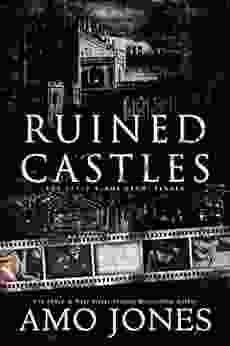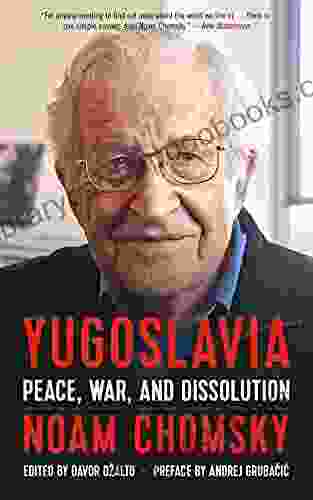Yugoslavia: Peace, War, and Dissolution

Yugoslavia, a former federation of six republics, emerged from the ashes of World War II as a beacon of hope for a peaceful and prosperous society. However, the seeds of its eventual dissolution were sown in the complex tapestry of its history, marked by a delicate balance of ethnicities, religions, and ideologies. This article delves into the intricate factors that shaped Yugoslavia's rise and fall, offering a comprehensive exploration of the forces that drove this nation from peace to war and ultimately to dissolution.
4.3 out of 5
| Language | : | English |
| File size | : | 1397 KB |
| Text-to-Speech | : | Enabled |
| Screen Reader | : | Supported |
| Enhanced typesetting | : | Enabled |
| Word Wise | : | Enabled |
| Print length | : | 241 pages |
Yugoslavia's Birth: A Post-War Promise
In the aftermath of World War II, Yugoslavia emerged as a unified nation under the charismatic leadership of Josip Broz Tito. Tito's communist regime played a crucial role in quelling ethnic tensions and fostering a sense of Yugoslav unity. The country's socialist economy experienced rapid growth, and Yugoslavia established itself as a non-aligned player on the international stage, skillfully navigating the Cold War divide.
Tito's legacy, however, was not without its flaws. While he successfully suppressed ethnic divisions during his lifetime, his death in 1980 created a vacuum that allowed nationalist sentiments to resurface. The cracks in Yugoslavia's unity began to widen.
Seeds of Division: Nationalism and Ethnic Tensions
Beneath the surface of Yugoslavia's post-war unity, ethnic tensions simmered. The country was a complex mosaic of different ethnic groups, each with their own distinct histories and aspirations. As communism weakened in the 1980s, nationalist movements gained momentum, challenging the federal government's authority.
In Croatia and Slovenia, nationalist leaders capitalized on economic grievances and stoked fears of Serbian domination. In Serbia, Slobodan Milosevic emerged as a powerful advocate for Serbian nationalism, exploiting historical grievances and a sense of Serbian victimhood.
The Breakup of Yugoslavia: A Tragic Conflict
In 1991, Slovenia and Croatia declared independence, triggering a bloody war that spread throughout Yugoslavia. The conflict was marked by ethnic cleansing, atrocities, and the displacement of millions of people.
The international community struggled to find effective solutions to the crisis. The United Nations deployed peacekeeping forces, but they were often overwhelmed by the violence. The United States and Europe imposed sanctions on Serbia, but these measures failed to stop the bloodshed.
Legacy and Lessons: Understanding Yugoslavia's Fall
The dissolution of Yugoslavia remains a haunting reminder of the fragility of peace and the destructive power of nationalism. It is a cautionary tale about the dangers of suppressing ethnic differences and the importance of fostering inclusive and democratic societies.
The lessons learned from Yugoslavia's breakup continue to resonate today. It emphasizes the need for peaceful conflict resolution, respect for human rights, and the promotion of dialogue and understanding among different ethnic and religious groups.
Yugoslavia's history is a complex and tragic one, marked by both periods of peace and war. The country's dissolution was a profound event that sent shockwaves throughout Europe and beyond. By understanding the forces that shaped Yugoslavia's rise and fall, we can better appreciate the challenges and opportunities of nation-building in a diverse and interconnected world.
In the end, Yugoslavia's story is a reminder that peace is a fragile flower that must be constantly nurtured and protected. It is a story that encourages us to learn from the mistakes of the past and to strive for a future where diversity is embraced and conflict is resolved through peaceful means.
4.3 out of 5
| Language | : | English |
| File size | : | 1397 KB |
| Text-to-Speech | : | Enabled |
| Screen Reader | : | Supported |
| Enhanced typesetting | : | Enabled |
| Word Wise | : | Enabled |
| Print length | : | 241 pages |
Do you want to contribute by writing guest posts on this blog?
Please contact us and send us a resume of previous articles that you have written.
 Book
Book Novel
Novel Page
Page Chapter
Chapter Text
Text Story
Story Genre
Genre Reader
Reader Library
Library Paperback
Paperback E-book
E-book Magazine
Magazine Newspaper
Newspaper Paragraph
Paragraph Sentence
Sentence Bookmark
Bookmark Shelf
Shelf Glossary
Glossary Bibliography
Bibliography Foreword
Foreword Preface
Preface Synopsis
Synopsis Annotation
Annotation Footnote
Footnote Manuscript
Manuscript Scroll
Scroll Codex
Codex Tome
Tome Bestseller
Bestseller Classics
Classics Library card
Library card Narrative
Narrative Biography
Biography Autobiography
Autobiography Memoir
Memoir Reference
Reference Encyclopedia
Encyclopedia Derrick Belanger
Derrick Belanger Nellie Moyo
Nellie Moyo Amos Gvirtz
Amos Gvirtz Samuel Charters
Samuel Charters Eryn Carpenter
Eryn Carpenter Lynne Kaufman
Lynne Kaufman Mike Gravel
Mike Gravel Anatole France
Anatole France Kimberley Montpetit
Kimberley Montpetit Amy Gutmann
Amy Gutmann Owen Laukkanen
Owen Laukkanen Sidney Bristol
Sidney Bristol Ashley Toliver
Ashley Toliver Amanda Nadelberg
Amanda Nadelberg Mick Hamer
Mick Hamer Piano Exercises
Piano Exercises Eric J Wittenberg
Eric J Wittenberg Gaby Morgan
Gaby Morgan W Craig Reed
W Craig Reed Stanley Taikeff
Stanley Taikeff
Light bulbAdvertise smarter! Our strategic ad space ensures maximum exposure. Reserve your spot today!

 Rudyard KiplingUnveiling the Secrets of Ruined Castles: A Journey Through the Elite Kings...
Rudyard KiplingUnveiling the Secrets of Ruined Castles: A Journey Through the Elite Kings...
 Dean ButlerLearn To Play Country Fiddle: A Beginner's Guide to Mastering the Heartfelt...
Dean ButlerLearn To Play Country Fiddle: A Beginner's Guide to Mastering the Heartfelt... Derek BellFollow ·11.1k
Derek BellFollow ·11.1k Michael CrichtonFollow ·4.9k
Michael CrichtonFollow ·4.9k Simon MitchellFollow ·13.3k
Simon MitchellFollow ·13.3k Heath PowellFollow ·17.5k
Heath PowellFollow ·17.5k Evan SimmonsFollow ·16.7k
Evan SimmonsFollow ·16.7k Gerald ParkerFollow ·16.4k
Gerald ParkerFollow ·16.4k Charles ReedFollow ·18.9k
Charles ReedFollow ·18.9k Mitch FosterFollow ·16.2k
Mitch FosterFollow ·16.2k

 Roald Dahl
Roald DahlImmerse Yourself in a Mesmerizing Tapestry of Creativity:...
Prepare to be captivated by "Spectra," an...

 Clarence Brooks
Clarence BrooksUnleash Your Inner Taylor with Red Piano Vocal Guitar:...
Embrace the Red Era...

 Jeffrey Hayes
Jeffrey HayesUnlock Your Child's Academic Potential: A Comprehensive...
In today's rapidly changing...

 William Golding
William GoldingBrave Elizabeth: A Captivating Tale of Resilience and...
Immerse Yourself in a Riveting Historical...

 Curtis Stewart
Curtis StewartUnveiling the Heartfelt Melodies of Taylor Swift: A...
Step into the enchanting world of Taylor...
4.3 out of 5
| Language | : | English |
| File size | : | 1397 KB |
| Text-to-Speech | : | Enabled |
| Screen Reader | : | Supported |
| Enhanced typesetting | : | Enabled |
| Word Wise | : | Enabled |
| Print length | : | 241 pages |










